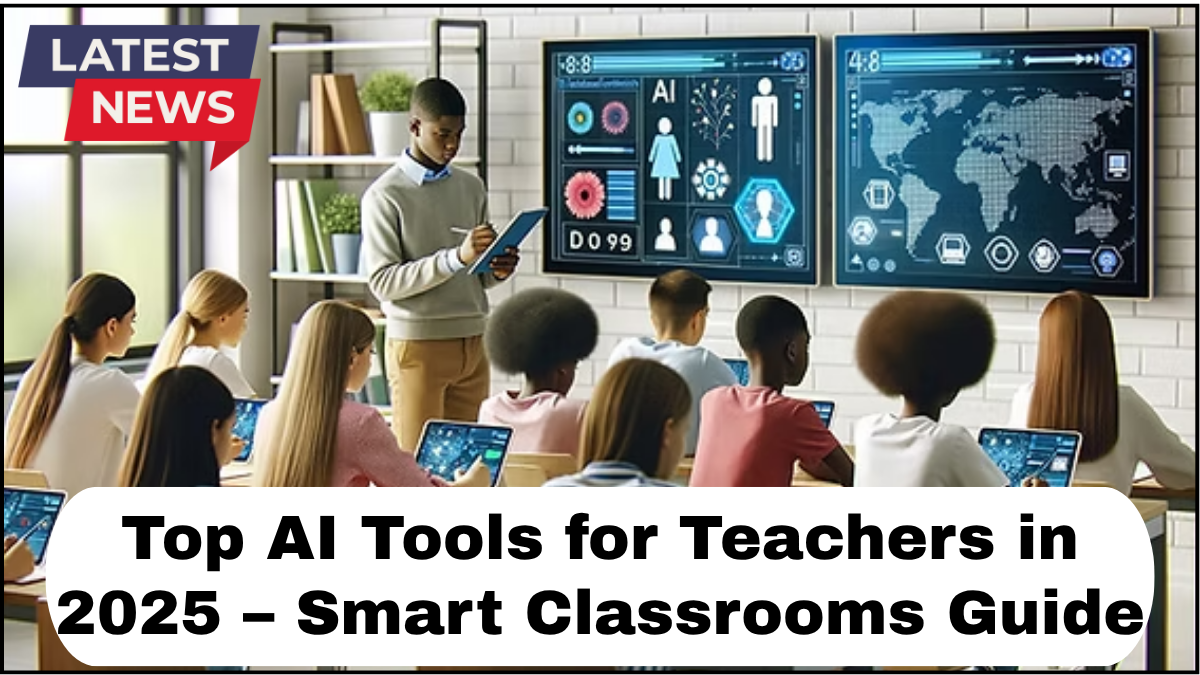The integration of AI tools for teachers is transforming education. In 2025, smart classrooms are more than just digital boards and tablets—they’re intelligent, adaptive, and centered around data-driven teaching. Teachers now have powerful platforms at their fingertips to personalize learning, automate administrative tasks, and enhance student engagement. This guide explores the top AI solutions reshaping classroom technology in 2025.

AI in the Classroom: A New Era of Teaching
Artificial Intelligence has matured beyond experimental stages. In 2025, it’s deeply embedded in classroom technology—from lesson planning and grading to behavioral analytics and real-time feedback systems. With the right tools, educators can shift their focus from routine management to meaningful student interaction.
Top AI Tools for Teachers in 2025
Here’s a breakdown of the most impactful AI-powered platforms every educator should know about.
1. Socratic by Google – Instant Student Support
Socratic remains a favorite among educators for its simplicity and power. Teachers encourage students to use it to independently explore answers by scanning problems. Powered by Google AI, it provides explanations, visual guides, and step-by-step help.
Why it’s valuable for teachers:
It fosters independent learning while easing the pressure on teachers to answer every question in real-time. Educators can spend more time facilitating deeper discussion.
2. Knewton Alta – Adaptive Learning at Scale
Knewton uses AI to tailor lessons based on real-time student performance. Its strength lies in analyzing data patterns to recommend next steps for learners, ensuring no student falls behind.
Teacher benefits:
-
Detailed learning analytics
-
Automated differentiation
-
Seamless integration with LMS platforms
This kind of classroom technology in 2025 means teachers no longer need to create multiple lesson paths manually.
3. Gradescope – AI-Powered Grading Assistant
Tired of endless grading? Gradescope speeds up the process with machine learning that reads and scores handwritten and digital assignments. It also groups similar answers to allow batch feedback.
Teacher impact:
-
Saves hours weekly
-
Ensures consistent grading
-
Enables feedback loops in large classrooms
It’s a perfect tool for STEM subjects, where grading can be time-intensive and repetitive.
4. TeachFX – Conversation Analytics for Classroom Talk
TeachFX records and analyzes classroom conversations to give teachers insight into student participation. It measures how much time teachers talk vs. students and tracks engagement by demographic groups.
Why it’s important:
It supports equity and inclusion by showing who’s participating—and who isn’t. It helps educators create more balanced and interactive class environments.
5. Eduaide.AI – Lesson Planning Made Smarter
Eduaide.AI is a complete teaching assistant that helps design lesson plans, quizzes, and learning objectives. Teachers input their subject and standards, and the AI generates compliant and engaging material in seconds.
Standout features:
-
Curriculum alignment
-
Multilingual support
-
Integration with various teaching styles (project-based, flipped classrooms, etc.)
In 2025, this tool is a major time-saver for busy teachers balancing content creation with instruction.
6. Class Companion – Real-Time Feedback Engine
This AI-powered writing assistant works with students’ essays and assignments, offering real-time grammar, structure, and clarity feedback—before the teacher even sees the final draft.
Why teachers love it:
-
Reduces back-and-forth corrections
-
Encourages student self-editing
-
Elevates final submission quality
It enhances the writing process while supporting the teacher’s role as a guide, not just a grader.
7. MagicSchool AI – All-in-One Educator Toolkit
Built specifically for educators, MagicSchool AI offers over 50 AI-powered tools in one dashboard. From parent email templates to IEP document drafts and behavior management tips, it’s a Swiss Army knife for modern teaching.
Classroom tech highlights:
-
Streamlines administrative tasks
-
Provides differentiated materials
-
Generates behavioral intervention plans
Perfect for reducing burnout and improving communication.
How AI Tools Are Reshaping Classroom Technology in 2025
Modern AI tools aren’t just add-ons—they’re deeply woven into the fabric of classroom operations. Here’s how they’re shifting teaching dynamics:
-
Personalization at scale – AI tailors content to individual student needs
-
Increased efficiency – Tasks like grading, planning, and analysis are automated
-
Data-driven insights – Teachers get real-time performance metrics and can adjust instruction faster
-
Enhanced accessibility – Multilingual and adaptive platforms ensure no student is left behind
The combination of AI tools for teachers and cutting-edge classroom technology in 2025 results in an education system that’s more responsive, inclusive, and effective.
FAQ – AI in Classrooms
Q1: Are AI tools replacing teachers in 2025?
No. AI tools support teachers by automating routine tasks and providing insights, but the human connection, judgment, and creativity of a teacher remain irreplaceable.
Q2: Is it safe to use AI tools with students?
Yes, most modern tools are FERPA- and GDPR-compliant. Still, schools should vet tools carefully to ensure student data privacy.
Q3: Can AI help with students who have learning disabilities?
Absolutely. AI-powered platforms can adapt content delivery, provide speech-to-text services, and personalize learning plans, greatly benefiting students with diverse needs.
Q4: Do teachers need special training to use these tools?
Some platforms offer built-in tutorials, while others may require brief professional development sessions. Most tools are designed to be intuitive and educator-friendly.
Q5: What’s the biggest advantage of AI tools in 2025 classrooms?
Efficiency and personalization. Teachers can do more with less time while giving each student the attention they deserve.
click here to learn more